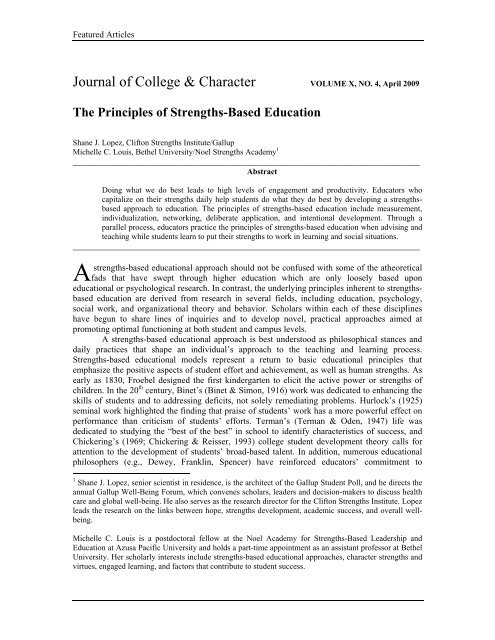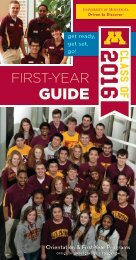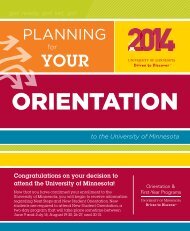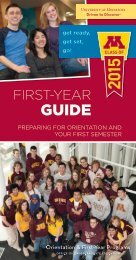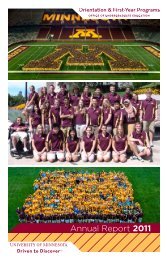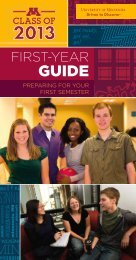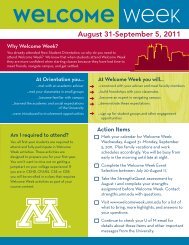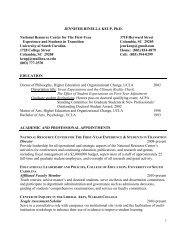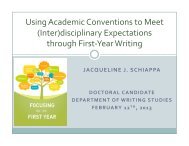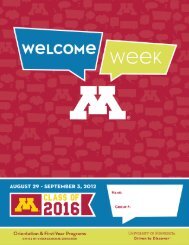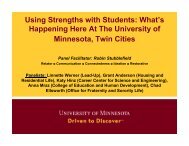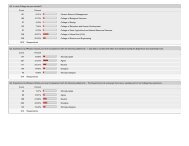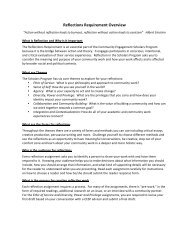The Principles of Strengths-Based Education - Orientation and First ...
The Principles of Strengths-Based Education - Orientation and First ...
The Principles of Strengths-Based Education - Orientation and First ...
You also want an ePaper? Increase the reach of your titles
YUMPU automatically turns print PDFs into web optimized ePapers that Google loves.
Featured Articles<br />
Journal <strong>of</strong> College & Character VOLUME X, NO. 4, April 2009<br />
<strong>The</strong> <strong>Principles</strong> <strong>of</strong> <strong>Strengths</strong>-<strong>Based</strong> <strong>Education</strong><br />
Shane J. Lopez, Clifton <strong>Strengths</strong> Institute/Gallup<br />
Michelle C. Louis, Bethel University/Noel <strong>Strengths</strong> Academy 1<br />
______________________________________________________________________________<br />
Abstract<br />
Doing what we do best leads to high levels <strong>of</strong> engagement <strong>and</strong> productivity. Educators who<br />
capitalize on their strengths daily help students do what they do best by developing a strengthsbased<br />
approach to education. <strong>The</strong> principles <strong>of</strong> strengths-based education include measurement,<br />
individualization, networking, deliberate application, <strong>and</strong> intentional development. Through a<br />
parallel process, educators practice the principles <strong>of</strong> strengths-based education when advising <strong>and</strong><br />
teaching while students learn to put their strengths to work in learning <strong>and</strong> social situations.<br />
______________________________________________________________________________<br />
A<br />
strengths-based educational approach should not be confused with some <strong>of</strong> the atheoretical<br />
fads that have swept through higher education which are only loosely based upon<br />
educational or psychological research. In contrast, the underlying principles inherent to strengthsbased<br />
education are derived from research in several fields, including education, psychology,<br />
social work, <strong>and</strong> organizational theory <strong>and</strong> behavior. Scholars within each <strong>of</strong> these disciplines<br />
have begun to share lines <strong>of</strong> inquiries <strong>and</strong> to develop novel, practical approaches aimed at<br />
promoting optimal functioning at both student <strong>and</strong> campus levels.<br />
A strengths-based educational approach is best understood as philosophical stances <strong>and</strong><br />
daily practices that shape an individual’s approach to the teaching <strong>and</strong> learning process.<br />
<strong>Strengths</strong>-based educational models represent a return to basic educational principles that<br />
emphasize the positive aspects <strong>of</strong> student effort <strong>and</strong> achievement, as well as human strengths. As<br />
early as 1830, Froebel designed the first kindergarten to elicit the active power or strengths <strong>of</strong><br />
children. In the 20 th century, Binet’s (Binet & Simon, 1916) work was dedicated to enhancing the<br />
skills <strong>of</strong> students <strong>and</strong> to addressing deficits, not solely remediating problems. Hurlock’s (1925)<br />
seminal work highlighted the finding that praise <strong>of</strong> students’ work has a more powerful effect on<br />
performance than criticism <strong>of</strong> students’ efforts. Terman’s (Terman & Oden, 1947) life was<br />
dedicated to studying the “best <strong>of</strong> the best” in school to identify characteristics <strong>of</strong> success, <strong>and</strong><br />
Chickering’s (1969; Chickering & Reisser, 1993) college student development theory calls for<br />
attention to the development <strong>of</strong> students’ broad-based talent. In addition, numerous educational<br />
philosophers (e.g., Dewey, Franklin, Spencer) have reinforced educators’ commitment to<br />
1 Shane J. Lopez, senior scientist in residence, is the architect <strong>of</strong> the Gallup Student Poll, <strong>and</strong> he directs the<br />
annual Gallup Well-Being Forum, which convenes scholars, leaders <strong>and</strong> decision-makers to discuss health<br />
care <strong>and</strong> global well-being. He also serves as the research director for the Clifton <strong>Strengths</strong> Institute. Lopez<br />
leads the research on the links between hope, strengths development, academic success, <strong>and</strong> overall wellbeing.<br />
Michelle C. Louis is a postdoctoral fellow at the Noel Academy for <strong>Strengths</strong>-<strong>Based</strong> Leadership <strong>and</strong><br />
<strong>Education</strong> at Azusa Pacific University <strong>and</strong> holds a part-time appointment as an assistant pr<strong>of</strong>essor at Bethel<br />
University. Her scholarly interests include strengths-based educational approaches, character strengths <strong>and</strong><br />
virtues, engaged learning, <strong>and</strong> factors that contribute to student success.
2 Journal <strong>of</strong> College <strong>and</strong> Character VOLUME X, NO 4, April 2009<br />
enhancing the best qualities <strong>of</strong> students. For example, Dewey (1938) believed that “the purpose <strong>of</strong><br />
education is to allow each individual to come into full possession <strong>of</strong> his or her personal power”<br />
(p. 10), a notion that is in alignment with a strengths-based educational approach.<br />
<strong>Strengths</strong>-based education, though grounded in historical tenets <strong>and</strong> practices, is also<br />
built on five modern-day educational principles: (a) the measurement <strong>of</strong> strengths, achievement<br />
(Carey, 2004; U.S. DOE, 2004), <strong>and</strong> determinants <strong>of</strong> positive outcomes (Lopez, 2004; Rettew &<br />
Lopez, 2009), (b) individualization, which requires a tailoring <strong>of</strong> the teacher’s/advisor’s methods<br />
to student needs <strong>and</strong> interests (Gallup, 2003; Levitz & Noel, 2000), (c) networking with friends,<br />
family, <strong>and</strong> pr<strong>of</strong>essionals who affirm strengths (Bowers, 2009), (d) deliberate application <strong>of</strong><br />
strengths in <strong>and</strong> out <strong>of</strong> the classroom (Rath, 2007; Seligman, Steen, Park, & Peterson, 2005), <strong>and</strong><br />
(e) intentional development <strong>of</strong> strengths through novel experience or focused practice across a<br />
period such as a semester, academic year, or an internship (Louis, 2008).<br />
<strong>The</strong> purpose <strong>of</strong> this article is to describe the components <strong>of</strong> strengths-based education as<br />
they are conducted on campuses today <strong>and</strong> to communicate an aspirational goal for future<br />
practices that could be increasingly effective at promoting positive student outcomes. A definition<br />
<strong>and</strong> description <strong>of</strong> strengths-based education provide an introductory context for this discussion.<br />
A<br />
<strong>The</strong> Definition <strong>and</strong> Practice <strong>of</strong> <strong>Strengths</strong>-<strong>Based</strong> <strong>Education</strong><br />
strengths perspective assumes that every individual has resources that can be mobilized<br />
toward success in many areas <strong>of</strong> life (Anderson, 2000; Saleebey, 2001) <strong>and</strong> is characterized<br />
by “efforts to label what is right” within people <strong>and</strong> organizations (Buckingham, 2007, p. 6). <strong>The</strong><br />
strengths philosophy explores ways to empower individuals to flourish rather than simply survive<br />
(Liesveld & Miller, 2005) <strong>and</strong> presupposes that capitalizing on one’s best qualities is likely to<br />
lead to greater success than would be possible by making a comparable investment <strong>of</strong> effort into<br />
overcoming personal weaknesses or deficiencies (Clifton & Harter, 2003; Clifton & Nelson,<br />
1992). <strong>Strengths</strong>-based education therefore is built upon these assumptions.<br />
<strong>Strengths</strong>-based education begins with educators discovering what they do best <strong>and</strong><br />
developing <strong>and</strong> applying their strengths as they help students identify <strong>and</strong> apply their strengths in<br />
the learning process so that they can reach previously unattained levels <strong>of</strong> personal excellence.<br />
Anderson (2004) exp<strong>and</strong>ed on this thinking about strengths-based education with the following:<br />
<strong>The</strong> process <strong>of</strong> strengths-based education involves educators intentionally <strong>and</strong><br />
systematically discovering their own talents <strong>and</strong> developing <strong>and</strong> applying strengths as<br />
they work to remain current in their fields, to improve their teaching methods, to design<br />
<strong>and</strong> implement their curriculum, <strong>and</strong> to establish programmatic activities to help students<br />
discover their talents <strong>and</strong> develop <strong>and</strong> apply strengths while learning substantive<br />
knowledge, acquiring academic skills, developing thinking <strong>and</strong> problem-solving skills,<br />
<strong>and</strong> demonstrating their learnings in educational settings to levels <strong>of</strong> excellence (p. 1).<br />
<strong>Strengths</strong>-based models embody a student-centered form <strong>of</strong> education with the primary<br />
goal <strong>of</strong> transforming students into confident, efficacious, lifelong learners whose work is infused<br />
with a sense <strong>of</strong> purpose (Anderson, 2000). As noted previously, a foundational assumption <strong>of</strong><br />
strengths-based education is that potential exists in all students <strong>and</strong> that educators do well to<br />
discover <strong>and</strong> implement the kinds <strong>of</strong> learning experiences that can help their students realize this<br />
potential.<br />
<strong>Strengths</strong>-based education has been established on hundreds <strong>of</strong> campuses in the U.S. <strong>and</strong><br />
Canada. <strong>The</strong> initial step in a strengths-based approach involves the measurement <strong>of</strong> strengths <strong>and</strong><br />
important educational indicators, such as hope, engagement, well-being, <strong>and</strong> other predictors <strong>of</strong><br />
______________________________________________________________________________
<strong>Strengths</strong>-<strong>Based</strong> <strong>Education</strong> 3<br />
attendance, achievement, credits earned, <strong>and</strong> retention. Although there are several measures that<br />
may be used to identify positive individual qualities, the most widely used assessment on<br />
campuses today is the Clifton <strong>Strengths</strong>Finder, an instrument developed by Gallup (1999) <strong>and</strong><br />
typically administered through <strong>Strengths</strong>Quest (Clifton, Anderson, & Schreiner, 2006), a resource<br />
that combines the assessment with additional information <strong>and</strong> learning activities designed for<br />
undergraduate populations. <strong>The</strong> Clifton <strong>Strengths</strong>Finder is an internet-based measure consisting<br />
<strong>of</strong> 178 paired comparison items <strong>and</strong> requires about 35 minutes for completion. Available in more<br />
than 20 languages, the instrument has been taken by over 500,000 students <strong>and</strong> 4 million people<br />
worldwide (Mark Pogue, personal communication, March 16, 2009). <strong>The</strong> Clifton <strong>Strengths</strong>Finder<br />
assesses 34 possible talent themes <strong>and</strong> provides respondents personal feedback on their five most<br />
dominant clusters <strong>of</strong> talent (referred to as signature themes), followed by descriptive statements<br />
about the themes <strong>and</strong> numerous recommended strategies or action items for capitalizing on each.<br />
<strong>The</strong> administration <strong>of</strong> the Clifton <strong>Strengths</strong>Finder is a common first step for most<br />
postsecondary institutions seeking to utilize a strengths-based educational model, <strong>and</strong> a rich<br />
diversity <strong>of</strong> curricula <strong>and</strong> programmatic efforts on today’s campuses support this instrument.To<br />
allow for a more rigorous examination <strong>of</strong> the effects <strong>of</strong> strengths-based approaches on<br />
engagement, achievement, well-being, retention, <strong>and</strong> job readiness, it may be useful to bring<br />
greater uniformity to strengths-based educational efforts in the future <strong>and</strong> to build such initiatives<br />
according to the five basic principles described subsequently.<br />
P<br />
<strong>The</strong> Five <strong>Principles</strong> <strong>of</strong> <strong>Strengths</strong>-<strong>Based</strong> <strong>Education</strong><br />
rinciple 1: Measurement <strong>of</strong> student (<strong>and</strong> educator) characteristics includes strengths<br />
assessment, which supplements the typical focus on academic achievement <strong>and</strong><br />
behavioral data (e.g., absences, living situation, <strong>of</strong>f-campus responsibilities, etc.).<br />
Educators rely on good data. Achievement tests (Carey, 2004; U.S. DOE, 2004) <strong>and</strong><br />
behavioral reports <strong>of</strong>ten shape perceptions <strong>of</strong> good students <strong>and</strong> effective schools more than any<br />
other type <strong>of</strong> assessment. Now, strengths <strong>and</strong> other positive personal variables (e.g., hope,<br />
engagement, <strong>and</strong> well-being) can be measured with confidence. By augmenting the existing data<br />
with data from measures <strong>of</strong> human strengths <strong>and</strong> other positive variables, educators can develop a<br />
more detailed <strong>and</strong> complex picture <strong>of</strong> academic success, its determinants, <strong>and</strong> its long-term<br />
benefits (Lopez, 2004).<br />
Educators measure what they value, <strong>and</strong> they work to enhance what they measure. Those<br />
within educational institutions have long valued achievement <strong>and</strong> its associated behaviors, yet<br />
boosting achievement, attendance, <strong>and</strong> retention has been a challenge. Potentially, student<br />
strengths <strong>and</strong> other indicators such as hope, engagement, <strong>and</strong> well-being might explain<br />
unaccounted variance in academic success. This hypothesis can only be examined when<br />
“positive” data are merged with existing data from large groups <strong>of</strong> American students.<br />
For students <strong>and</strong> educators, measurement <strong>of</strong> strengths also has some short-term benefits.<br />
Upon completion <strong>of</strong> the Clifton <strong>Strengths</strong>Finder, individuals receive five positive words for<br />
describing themselves. Students can carry these descriptors with them throughout their college<br />
career <strong>and</strong> into their first job <strong>and</strong> share them with their family <strong>and</strong> friends. Educators can do more<br />
<strong>of</strong> what they do best throughout their career by being mindful <strong>of</strong> their strengths.<br />
Principle 2: Educators personalize the learning experience by practicing individualization<br />
whereby they think about <strong>and</strong> act upon the strengths <strong>of</strong> each student.<br />
A strengths-based approach to working with students can be highly individualized,<br />
including efforts to personalize the learning experience (Gallup, 2003) by encouraging students to<br />
set goals based on their strengths <strong>and</strong> helping them to apply their strengths in novel ways<br />
______________________________________________________________________________
4 Journal <strong>of</strong> College <strong>and</strong> Character VOLUME X, NO 4, April 2009<br />
(Cantwell, 2005) as part <strong>of</strong> a developmental process (Louis, 2008). Specifically, individualization<br />
involves educational pr<strong>of</strong>essionals spontaneously thinking about <strong>and</strong> acting upon the strengths,<br />
interests, <strong>and</strong> needs <strong>of</strong> each student <strong>and</strong> systematically making efforts to personalize the learning<br />
experience (Gallup, 2003; Levitz & Noel, 2000). Through individualization efforts, educators (a)<br />
highlight unique student qualities <strong>and</strong> goals that make academic <strong>and</strong> social pursuits more<br />
successful <strong>and</strong> (b) provide feedback on the use <strong>of</strong> these qualities <strong>and</strong> on their role in the<br />
successful pursuit <strong>of</strong> meaningful goals. For individualization to be effective, the educator needs to<br />
begin helping the student to talk about goals within the context <strong>of</strong> personal strengths. Educator<br />
<strong>and</strong> student need to know “where they are” <strong>and</strong> “where they are going” <strong>and</strong> how strengths can<br />
help provide a pathway between these two. An underst<strong>and</strong>ing <strong>of</strong> personal goals (goals crafted by<br />
the student) <strong>and</strong> assigned goals (encouraged by the educator or institution) defines the aims <strong>and</strong><br />
objects being pursued <strong>and</strong> creates many opportunities for feedback on goal pursuit. <strong>The</strong>se mutual<br />
goals direct attention <strong>and</strong> effort, serve an energizing function, contribute to persistence, <strong>and</strong> spark<br />
action indirectly by leading to interests, discoveries, <strong>and</strong> use <strong>of</strong> knowledge, strategies, <strong>and</strong> skills<br />
(Locke & Latham, 2002).<br />
Another practical approach to individualization involves the educator providing several<br />
options for how student learning can be demonstrated <strong>and</strong> assessed, allowing students to select<br />
the project or assessment type that most closely resonates with their own particular constellation<br />
<strong>of</strong> strengths. Potent <strong>and</strong> timely feedback addresses the development <strong>of</strong> life strategies grounded in<br />
knowledge <strong>of</strong> strengths <strong>and</strong> comments on goal pursuits. Formative feedback that puts progress<br />
into perspective should be augmented with summative feedback that emphasizes the strengths <strong>and</strong><br />
strategies used for recent goal attainment.<br />
Principle 3: Networking with personal supporters <strong>of</strong> strengths development affirms the best<br />
in people <strong>and</strong> provides praise <strong>and</strong> recognition for strengths-based successes.<br />
“<strong>Strengths</strong> develop best in response to other human beings” (Clifton & Nelson, 1992, p.<br />
124). Clifton believed that relationships help define who we are <strong>and</strong> who we can become,<br />
positioning strengths as the qualities that establish connections between people whereas<br />
weaknesses create division in relationships (Clifton & Nelson). As relational connections grow<br />
with the help <strong>of</strong> social networking, strengths-based education <strong>and</strong> development could blossom<br />
within new relationships <strong>and</strong> long-term, high quality relationships.<br />
When educators are mindful <strong>of</strong> students’ strengths, they can help students to become<br />
empowered while strengthening the mentoring relationship. As students discover their own<br />
strengths, they can share that new information <strong>and</strong> also work to think <strong>of</strong> other people in terms <strong>of</strong><br />
their strengths. For example, when providing feedback to a fellow student, a person could begin<br />
by highlighting what was done well <strong>and</strong> why (i.e., which strengths were showcased) rather than<br />
what was done poorly <strong>and</strong> why (i.e., which weaknesses undermined performance).<br />
In the context <strong>of</strong> close relationships, the strengths <strong>of</strong> others may be leveraged to manage<br />
personal weaknesses. By building strengths collaboratives, two individuals (or a larger group <strong>of</strong><br />
people) can bring their best talents to projects while filling the gaps by sharing personal<br />
resources. In effective strengths-based models, educators use strengths to help others achieve<br />
excellence <strong>and</strong> to move beyond an individual focus to a more relational perspective.<br />
Bowers (2009) heard the declaration “I have many supports in my life” repeatedly when<br />
interviewing college students who were nominated as the best at making the most <strong>of</strong> their<br />
strengths. One interpretation <strong>of</strong> this discovery is that high levels <strong>of</strong> social support are associated<br />
with the ability to become adept at using personal strengths. Alternatively, strengths-based<br />
education may reveal that networking around strengths produces increased social support.<br />
______________________________________________________________________________
<strong>Strengths</strong>-<strong>Based</strong> <strong>Education</strong> 5<br />
Principle 4: Deliberate application <strong>of</strong> strengths within <strong>and</strong> outside <strong>of</strong> the classroom fosters<br />
development <strong>and</strong> integration <strong>of</strong> new behaviors associated with positive outcomes.<br />
A focus on the deliberate application <strong>of</strong> strengths within the classroom shapes the<br />
behaviors <strong>of</strong> educators <strong>and</strong> students <strong>and</strong> the nature <strong>of</strong> education in several notable ways.<br />
Specifically, educators utilizing a strengths-based stance begin by selecting pedagogical<br />
approaches that bring out their best in the educational process <strong>and</strong> seek to model how they<br />
leverage personal strengths in teaching, advising, or other domains <strong>of</strong> life. Such educators<br />
regularly discuss strengths application with students, providing personal examples or illustrations<br />
<strong>and</strong> describing some <strong>of</strong> the experiences that were critical in their own process <strong>of</strong> developing<br />
strengths.<br />
Building upon the idea that “to educate” literally means “to draw out” or “to bring forth,”<br />
strengths-based educators believe that part <strong>of</strong> their core responsibility is to draw out the strengths<br />
that exist within students by heightening students’ awareness <strong>of</strong> them <strong>and</strong> cultivating a greater<br />
future orientation around how students’ strengths might be catalyzed as they approach their<br />
education. Teaching from a strengths-based perspective requires educators to devote effort to<br />
helping students notice <strong>and</strong> identify occasions when their strengths are evident in the classroom<br />
or when they are using personal strengths to complete assignments with a high level <strong>of</strong> quality. A<br />
strengths-based educator also fosters a learning environment in which affirming peer-to-peer<br />
feedback is a regular feature, as students are taught to cultivate the skill <strong>of</strong> noting their<br />
classmates’ strengths in action. Creating opportunities for students to choose assignment types<br />
that allow them to leverage their unique strengths provides practice in selecting activities that will<br />
bring out their best.<br />
<strong>The</strong>se recommendations are resonant with the core ideas <strong>of</strong> self-determination theory,<br />
which explains that individuals function at optimal levels <strong>and</strong> are most authentically motivated<br />
when three psychological needs are met: competence, autonomy, <strong>and</strong> relatedness (Ryan & Deci,<br />
2000). Helping students underst<strong>and</strong> the connection between their strengths <strong>and</strong> their personal<br />
goals <strong>and</strong> <strong>of</strong>fering guidance in the application <strong>of</strong> their strengths in the most effective ways can<br />
elicit feelings <strong>of</strong> competence, <strong>and</strong> providing students with choices <strong>and</strong> opportunities for selfdirection<br />
can support their need for autonomy. When educators establish a learning culture where<br />
students view themselves <strong>and</strong> others through strengths-colored glasses (Clifton, Anderson, &<br />
Schreiner, 2006), they help to foster appreciation for differences, highlight the value <strong>of</strong><br />
collaboration <strong>and</strong> teamwork, <strong>and</strong> establish a powerful sense <strong>of</strong> relatedness.<br />
Principle 5: Intentional development <strong>of</strong> strengths requires that educators <strong>and</strong> students<br />
actively seek out novel experiences <strong>and</strong> previously unexplored venues for focused practice<br />
<strong>of</strong> their strengths through strategic course selection, use <strong>of</strong> campus resources, involvement<br />
in extracurricular activities, internships, mentoring relationships, or other targeted growth<br />
opportunities.<br />
Highly effective strengths educators underst<strong>and</strong> that the ultimate objective <strong>of</strong> a strengthsbased<br />
initiative is to help students consider their own responsibility in deliberately, attentively<br />
developing their strengths through practice <strong>and</strong> engagement in novel experiences. This final<br />
principle builds upon the others by suggesting that if students are to maximize their strengths,<br />
they will need to cultivate the discipline <strong>of</strong> proactively seeking new experiences that will expose<br />
them to information, resources, or opportunities to heighten their skills <strong>and</strong> knowledge about how<br />
to mobilize their strengths most effectively. This undertaking requires more than an innovative<br />
application <strong>of</strong> strengths in existing settings, but dem<strong>and</strong>s engagement in new experiences<br />
designed to exp<strong>and</strong> personal strengths.<br />
An ideal strengths-based educational model highlights the investment <strong>of</strong> effort <strong>and</strong> the<br />
creation <strong>of</strong> a strengths growth plan as critical components in a developmental process, <strong>and</strong> invites<br />
______________________________________________________________________________
6 Journal <strong>of</strong> College <strong>and</strong> Character VOLUME X, NO 4, April 2009<br />
students to consider how they might formulate new strategies or access previously unutilized<br />
resources to aid them in the process <strong>of</strong> developing their strengths. <strong>The</strong> importance <strong>of</strong> including<br />
messages within strengths-based approaches related to seeking new experiences <strong>and</strong> applying<br />
effort is most apparent when considered within the context <strong>of</strong> research which suggests that<br />
students’ implicit self-theories, or beliefs about the degree to which their personal abilities are<br />
malleable, exert pr<strong>of</strong>ound effects on behavior within educational environments (Dweck &<br />
Molden, 2005). Students with a fixed mindset believe that personal attributes are constant, traitlike<br />
qualities that are not largely amenable to change efforts; students with a fixed mindset<br />
frequently believe that hard work reveals a lack <strong>of</strong> innate ability <strong>and</strong> therefore are more likely to<br />
eschew tasks that require prolonged effort (Blackwell, Trzesniewski, & Dweck, 2007). In<br />
contrast, students with a growth mindset adhere to the belief that personal abilities are responsive<br />
to developmental efforts (Dweck, 1999); such students <strong>of</strong>ten view the exertion <strong>of</strong> effort as a<br />
prerequisite for developing their abilities <strong>and</strong> therefore as something to be embraced.<br />
Brief interventions can influence mindset (Aronson, Fried, & Good, 2002; Kamins &<br />
Dweck, 1999). Counterintuitively, highlighting a student’s positive traits or innate abilities<br />
actually can undermine future performance because affirming students’ traits alone not only leads<br />
to a fixed mindset, but also to an ultimate decline in motivation if students are not also taught to<br />
be mindful <strong>of</strong> the importance <strong>of</strong> effort in producing positive outcomes (Mueller & Dweck, 1998).<br />
Educators must frame strengths-based approaches as a part <strong>of</strong> a developmental process that<br />
requires intentionality <strong>and</strong> effort, because merely to identify <strong>and</strong> affirm talent may inadvertently<br />
encourage students to adopt more readily a fixed mindset <strong>and</strong> to embrace the unrealistic<br />
expectation that the mere presence <strong>of</strong> personal talents is sufficient to navigate the challenges they<br />
will encounter in the college setting (Louis, 2008).<br />
Intentionality also requires that educators approach strengths-based education from a<br />
developmental perspective, conceptualizing strengths not as static traits but as dynamic qualities<br />
that can be developed over time. A shift away from brief strengths interventions occurring within<br />
a single class or programmatic area <strong>of</strong> an institution to coordinated cross-departmental initiatives<br />
would better account for students’ developmental needs <strong>and</strong> goals at various stages <strong>of</strong> their<br />
collegiate experience.<br />
T<br />
<strong>The</strong> <strong>Principles</strong> in Action<br />
hese five principles need not be exercised in this particular order, yet the flow does represent<br />
what is typical on campuses today. Educators who know their own strengths catalyze the<br />
strengths development process for students, whereby the educator directs the student to complete<br />
strengths measures <strong>and</strong> provides individualized attention. Educators are responsible for their own<br />
networking, deliberate application, <strong>and</strong> intentional development, but results are best when<br />
colleagues support strengths development within the campus community at large. One or more<br />
educators are then equipped to guide students through networking, application, <strong>and</strong> development,<br />
applying concerted effort over time to integrate strengths-based practices.<br />
With these principles <strong>of</strong> strengths-based education in mind, practices designed to identify<br />
<strong>and</strong> marshal the academic <strong>and</strong> psychological resources <strong>of</strong> each educator <strong>and</strong> student can be<br />
created, examined, <strong>and</strong> refined.<br />
______________________________________________________________________________
<strong>Strengths</strong>-<strong>Based</strong> <strong>Education</strong> 7<br />
References<br />
Anderson, E. C. (2000, February). Affirming students’ strengths in the critical years. Paper<br />
presented at the National Conference on the <strong>First</strong> Year Experience, Columbia, SC.<br />
Anderson, E. C. (2004). What is strengths-based education: A tentative answer by someone who<br />
strives to be a strengths-based educator. Unpublished manuscript.<br />
Aronson, J., Fried, C., & Good, C. (2002). Reducing the effects <strong>of</strong> stereotype threat on African<br />
American college students by shaping theories <strong>of</strong> intelligence. Journal <strong>of</strong> Experimental<br />
Social Psychology, 38, 113-125.<br />
Binet, A., & Simon, T. (1916). <strong>The</strong> development <strong>of</strong> intelligence in children (E. S. Kit, Trans.).<br />
Baltimore: Williams <strong>and</strong> Wilkins.<br />
Blackwell, L. S., Trzesniewski, K. H., & Dweck, C. S. (2007). Implicit theories <strong>of</strong> intelligence<br />
predict achievement across an adolescent transition: A longitudinal study <strong>and</strong> an<br />
intervention. Child Development, 78(1), 246-263.<br />
Bowers, K. (2009). Making the most <strong>of</strong> human strengths. In S. J. Lopez (Ed.) Positive<br />
psychology: Exploring the best in people: Discovering human strengths (pp. 23-36).<br />
Westport, CT: Praeger.<br />
Buckingham, M. (2007). Go put your strengths to work. New York: Free Press.<br />
Cantwell, L. (2005). A comparative analysis <strong>of</strong> strengths-based versus traditional teaching<br />
methods in a freshman public speaking course: Impacts on student learning <strong>and</strong><br />
engagement. Dissertation Abstracts International, 67(02A), 478-700. (UMI No.<br />
AAT3207574)<br />
Carey, K. (2004). A matter <strong>of</strong> degrees: Improving graduation rates in four-year colleges <strong>and</strong><br />
universities. Washington, D. C.: <strong>Education</strong> Trust.<br />
Chickering, A. W. (1969). <strong>Education</strong> <strong>and</strong> identity. San Francisco: Jossey-Bass.<br />
Chickering, A. W., & Reisser, L. (1993). <strong>Education</strong> <strong>and</strong> identity. San Francisco: Jossey-Bass.<br />
Clifton, D. O., Anderson, C. E., & Schreiner, L. A. (2006). <strong>Strengths</strong>Quest: Discover <strong>and</strong> develop<br />
your strengths in academics, career, <strong>and</strong> beyond (2nd ed.). New York: Gallup Press.<br />
Clifton, D. O., & Harter, J. K. (2003). Investing in strengths. In K. S. Cameron, J. E. Dutton, & R.<br />
E. Quinn (Eds.), Positive organizational scholarship (pp. 111-121). San Francisco:<br />
Berrett-Koehler.<br />
Clifton, D. O., & Nelson, P. (1992). Soar with your strengths. New York: Dell.<br />
Dewey, J. (1938). Experience in education. New York: Collier.<br />
Dweck, C. S. (1999). Self-theories: <strong>The</strong>ir role in motivation, personality, <strong>and</strong> development.<br />
Philadelphia: Psychology Press.<br />
Dweck, C. S., & Molden, D. C. (2005). Self-theories: <strong>The</strong>ir impact on competence motivation<br />
<strong>and</strong> acquisition. In A. J. Elliott & C. S. Dweck (Eds.), H<strong>and</strong>book <strong>of</strong> competence <strong>and</strong><br />
motivation (pp. 122-140). New York: Guilford Press.<br />
Gallup. (1999). Clifton <strong>Strengths</strong>Finder. Washington, DC: Author.<br />
Gallup. (2003). Teaching <strong>and</strong> leading with individualization. Retrieved June 26, 2007, from<br />
http://media.gallup.com/EDUCATION/pdf/TeachingAndLeadingWithIndividualization2<br />
0030508.pdf<br />
Hurlock, E. B. (1925). An evaluation <strong>of</strong> certain incentives used in school work. Journal <strong>of</strong><br />
<strong>Education</strong>al Psychology, 16, 145-159.<br />
Kamins, M., & Dweck, C. S. (1999). Person versus process praise <strong>and</strong> criticism: Implications for<br />
contingent self-worth <strong>and</strong> coping. Developmental Psychology, 35, 835-847.<br />
Levitz, R., & Noel, L. (2000). <strong>The</strong> earth-shaking, but quiet revolution, in retention management.<br />
Retrieved on August 6, 2004, from www.noellevitz.com<br />
______________________________________________________________________________
8 Journal <strong>of</strong> College <strong>and</strong> Character VOLUME X, NO 4, April 2009<br />
Liesveld, R., & Miller, J. A. (2005). Teach with your strengths: How great teachers inspire their<br />
students. New York: Gallup Press.<br />
Locke, E., & Latham, G. P. (2002). Building a practically useful theory <strong>of</strong> goal setting <strong>and</strong> task<br />
motivation: A 35‐year odyssey. American Psychologist, 57, 705‐717.<br />
Lopez, S. J. (2004). Naming, nurturing, <strong>and</strong> navigating: Capitalizing on strengths in daily life.<br />
National Conference on Building a <strong>Strengths</strong>-<strong>Based</strong> Campus: Best Practices in<br />
Maximizing Student Performance: Omaha, NE.<br />
Louis, M. C. (2008). A comparative analysis <strong>of</strong> the effectiveness <strong>of</strong> strengths-based curricula in<br />
promoting first-year college student success. Dissertation Abstracts International,<br />
69(06A). (UMI No. AAT 3321378).<br />
Mueller, C. M., & Dweck, C. S. (1998). Intelligence praise can undermine motivation <strong>and</strong><br />
performance. Journal <strong>of</strong> Personality <strong>and</strong> Social Psychology, 75, 33-52.<br />
Rath, T. (2007). <strong>Strengths</strong>Finder 2.0. New York: Gallup Press.<br />
Rettew, J. G., & Lopez, S. J. (2009). Discovering your strengths. In S. J. Lopez (Ed.) Positive<br />
psychology: Exploring the best in people: Discovering human strengths (pp. 1-21).<br />
Westport, CT: Praeger.<br />
Ryan, R. M, & Deci, E. L. (2000). Self-determination theory <strong>and</strong> the facilitation <strong>of</strong> intrinsic<br />
motivation, social development, <strong>and</strong> well-being. American Psychologist, 55(1), 66-78.<br />
Saleebey, D. (2001). Human behavior <strong>and</strong> social environments: A biopsychosocial approach.<br />
New York: Columbia University Press.<br />
Seligman, M. E. P., Steen, T., Park, N., & Peterson, C. (2005). Positive psychology progress:<br />
Empirical validation <strong>of</strong> interventions. American Psychologist, 60, 410-421.<br />
Terman, L. M., & Oden, M H. (1947). <strong>The</strong> gifted child grows up: Twenty-five years’ follow-up <strong>of</strong><br />
a superior group. Stanford, CA: Stanford University Press.<br />
United States Department <strong>of</strong> <strong>Education</strong>. (2004). Performance measure <strong>and</strong> accountability.<br />
Available at http://www.ed.gov/about/<strong>of</strong>fices/list/ovae/pi/cte/perfmeas.html<br />
______________________________________________________________________________


